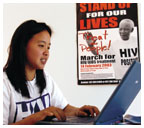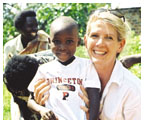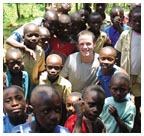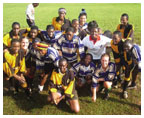November 3, 2004: Features
“Recently, when someone called to ask what we can do for treatment for his sister, I was actually able to call him back and say, ‘The hospital where you live is now providing antiretrovirals, they’re free, and you can call this doctor to get them!’”
Iming Lin '03 works in her home in Cape Town, South Africa, under a poster of Nelson Mandela wearing a T-shirt that is sold to raise money for the Treatment Action Campaign, which works with people who have HIV/AIDS. “There are a lot of people who want to do service on a global scale ... They’ve seen what happened in Rwanda, and what’s happening in Sudan, and they realize Africa is the most needy.”
PiAf Executive Director Holly Sanderson Schade ’91 after distributing Princeton T-shirts to children in rural Uganda in May. As PiAf fellows soon learn, the ability to acknowledge and adapt to Africa’s often contradictory character is the cornerstone to understanding and functioning in this complex continent.
Addison Thompson ’02, center, with school children in Cyangugu, Rwanda, in February 2003. Drawing on three years of playing rugby at Princeton, Culbertson also helped boost Uganda’s first women’s rugby team ... and captained its B-team to victory at an international tournament in Nairobi.
Erin Culbertson ’03, second from left, with the Ugandan women’s rugby team, at its first international tournament in Kenya. |
Into
Africa
Princeton-in-Africa builds on burgeoning interest in the “Forgotten
Continent”
By Douglas Bennett Lee ’75
Cape Town, South Africa – Iming Lin ’03 has a sunny smile and a merry laugh that comes easily and often. She wears blue jogging shorts, a yellow T-shirt that says “Velveeta,” and dusty brown sandals. She’s been living here near Cape Town, South Africa, since July of last year, working with an organization trying to stem the tide of suffering and death that is the HIV/AIDS pandemic sweeping this continent.
The organization, called TAC, an acronym for Treatment Action Campaign, is a grassroots movement that sprang up in response to the South African government’s refusal, reversed only in 2003, to acknowledge that contagion with HIV leads to AIDS, and its reluctance to provide antiretroviral drugs for AIDS sufferers. Lin’s job is fund raising for a treatment program that cares for the caregivers by providing antiretrovirals and counseling for TAC volunteers who develop full-blown AIDS.
Her involvement on the front line of one of the world’s most urgent and complex medical and social challenges comes about through a young enterprise with large ambitions. Princeton-in-Africa (PiAf) was founded in 2000 to place Princeton graduates and students in fellowships at vital positions with humanitarian agencies and other service-oriented, educational, and agricultural organizations doing hands-on work in Africa. The program had four fellows in its first year; this fall there are 14, most on year-long internships with partner organizations ranging from the International Rescue Committee, out to save lives; to Plan International, out to improve children’s lives; to Save the Elephants.
Thirteen undergraduate interns spent shorter terms in Africa this past summer. All told, Princeton-in-Africa fellows and interns have worked in a dozen African nations this year, and the program is expected to grow: PiAf’s directors hope to find funding for 20 fellows next year.
The program’s ultimate and far-reaching purpose: to build a cadre of future leaders with deep ties and commitments to what has been called the “Forgotten Continent.”
Lin is a Californian from the San Francisco Bay area, a first-generation Chinese-American who originally came to this tip of Africa on her junior year abroad at the University of Cape Town. Upon seeing its mountains and feeling its fresh sea breezes, Lin felt an immediate sense of belonging.
Lin’s work today as a PiAf fellow takes her far from Cape Town’s celebrated vistas and fresh air, deep into the warren of dusty and sometimes dangerous streets that constitute Khayelitsha, a township of perhaps a million souls created during the apartheid regime’s policy of forced resettlement of black South Africans. Shacks constructed of plastic bags, bits of cardboard, and flattened tin cans stand beside the carefully tended yards and gardens of neat tile-roofed, cinder-block houses built by the government since the coming of democratic rule in 1994.
Lin plunges into the welter with gusto at TAC’s regional office and treatment site in Khayelitsha’s bustling commercial center. The tragedy of AIDS in Africa is of a magnitude hard for an outsider to grasp, much less deal with every day. But in the office’s busy halls, beside a poster featuring Nelson Mandela wearing a TAC T-shirt that says HIV POSITIVE, Lin greets and hugs volunteers who brighten and smile back when they see her. She handles several jobs in her volunteer capacity, coordinating national and international sales of these attention-arresting T-shirts, as well as organizing public events and working with TAC’s international volunteers.
“The greatest thing has been seeing the difference since President Mbeki admitted that HIV causes AIDS,” says Lin, a talented photographer who took Polaroid portraits of HIV-infected residents of Khayelitsha for her Princeton minor in visual arts. (She majored in sociology.) “And now the campaign for the National Treatment Program is actually rolling out, starting at 18 treatment sites here in Western Cape Province. So, recently, when someone called to ask what we can do for treatment for his sister, I was actually able to call him back and say, ‘The hospital where you live is now providing antiretrovirals, they’re free, and you can call this doctor to get them!’”
Princeton-in-Africa was born in 2000, as the brainchild of a handful of Princetonians who had interests or personal experiences in Africa. Princeton-in-Asia recently had celebrated its 100th birthday and was enjoying a high profile on campus, which made them wonder: Why wasn’t there a Princeton-in-Africa program doing similar work? There was George Hritz ’69, who had long been involved with international aid and relief work. His classmate Jim Floyd ’69 was active in Princeton Project ’55 and the Class of 1969’s Community Service Fund. Paula Chow, director of the International Center, drew on her experience working with international students. And the Rev. Frank Strasburger ’67 came with a love of Africa that grew from living near Cape Town for several weeks on a family trip in 1993. In 2000, Strasburger became the first president of Princeton-in-Africa’s board of directors, and the organizers studied what shape their new group should take. “We asked ourselves what in particular we had to offer,” Strasburger recalls. “We knew that there were a lot of NGOs [nongovernmental organizations] doing fantastic aid and relief work in Africa, and that we had neither the same expertise nor logistical capacity.
“We were very concerned about the dearth of commitment to understanding African issues among the current crop of leaders across the countries in the West,” he continues, “and most of all in this country. We zeroed in on what we had sitting around that table, and realized it was access to the best and the brightest of a future generation of leaders. And what gradually came into focus was a mission — to create a growing constituency of young leaders committed to the emergence of Africa as a full partner in the developed world.”
The launching of PiAf has coincided with a surge of undergraduate and academic interest in African studies echoed on many college campuses across the country in an awakening to Africa’s cultural and historical richness, and to its economic and political significance. The Institute of International Education reports a five-fold increase in American undergraduates studying in Africa between 1990 and the academic year 2000—01, from fewer than a thousand to more than 4,500. The percentage of American students abroad who chose to study in Africa has nearly doubled during that period, to over 3 percent – small, but significant in its growth.
A number of factors have contributed to Africa’s rising profile on American campuses. Academic access has increased with the end of apartheid in South Africa, opening the sub-Saharan continent’s leading intellectual and economic engine to full engagement with the West and the rest of Africa. Other democracies and nascent economies are struggling to emerge, and the changing political climate is catching the attention of American academia for the first time since the flush of optimism (largely disappointed) following the widespread achievement of independence from colonialism in the 1960s.
Princeton-in-Africa’s first full-time director, Holly Sanderson Schade ’91, believes that American students’ attitudes toward involvement with the world has something to do with it. “There are a lot of people who want to do service on a global scale,” she says. “They’ve seen what happened in Rwanda, and what’s happening in Sudan, and they realize Africa is the most needy.”
Professor Emanuel Kreike, former director of the University’s Program in African Studies, a certificate program, and vice president of Princeton-in-Africa, sees a pragmatic need for American students’ engagement with the world’s poorest continent. “In this increasingly globalized world, Africa is going to become increasingly important, economically, socially, and culturally. It is a potentially huge market, and it can only go up. In the next five years, the biggest growth opportunities are going to be in Africa, despite all the difficulties politically.”
As Princeton’s student body has become increasingly diverse, more individuals with interests or background in Africa arrive on campus. Kreike has noted an increase in American students who have visited Africa with their parents, and in first-generation African-Americans, both white and black, who have ties to their parents’ countries of origin. At Princeton, this surging interest translates into weekly meetings of the Indaba, Zulu for “gathering” or “council,” an informal breakfast get-together of Princeton students and faculty with interests in Africa that regularly draws 30 or more attendees. Members of an Africanist student association called Akwaaba, Ashanti for “welcome,” are very active on campus, successfully appealing two years ago for a permanent lecturer in Swahili. Undergraduate enrollment in the Program in African Studies has quadrupled from “maybe five or six” a few years ago, according to Kreike, to 22 participants this semester. The academic scope of the program has also grown.
“When I came here in 1997, there were maybe a dozen people on the faculty working on Africa in one way or another,” Kreike recalls. “Now it’s about double that number, and it’s a more diverse group.”
A wider range of offerings and word-of-mouth endorsements have brought student interest to an unprecedented level. “I’m teaching a course now on southern Africa’s precolonial history” – a course, he suggests, that was until recently less than high-profile. “Well, I have 60 students pre-enrolled.”
“It’s part of a general broadening of consciousness to a world outside Europe,” says Professor Jeffrey Herbst ’83, chairman of the politics department (on leave this year) and a PiAf board member. He headed the faculty-student committee on study abroad for many years, and watched a shift in student preferences occur. “Twenty years ago, study abroad meant going to Europe. Now it’s much more diverse,” he says, noting that a large contingent of Princetonians spends time at the University of Cape Town. (According to Associate Dean of the College Nancy Kanach, who oversees study abroad, 132 Princeton students have studied at the University of Cape Town since the program began in 1995, and at times, the number of Princetonians there has been second only to the number at Oxford University.) “I don’t think any other American university has that kind of relationship with an African institution,” Herbst says. “Students come to see Africa not just as some exotic place, but also a place where you can do service.”
Since PiAf was born, it has placed nearly 70 recent graduates in a dozen African countries. Only one in three PiAf applicants is accepted as a fellow. But the very level of PiAf’s achievers can be a pitfall when leaving Princeton’s ivy-covered walls for an African thorn-bush kraal. Kreike cautions his students, many of whom become PiAf fellows: “You need to have a certain openness and humility. You can’t go there, as we have done too often, and say, OK, you and you do this, it’s what best for your village. That’s colonial history. And it’s easy to fall into when you come from a place like Princeton, where you’re told, ‘You’re the people who are going to be the leaders of the world.’ You have to listen.”
Kreike speaks from African experience. He’s spent seven of the past 12 years there, conducting his own research and working with the United Nation’s high commissioner for refugees. He’s seen many faces of modern Africa, both innocent and evil. During a holdup in Mozambique, young teenagers with AK-47 assault rifles stopped Kreike and a local colleague in an ambush as their truck churned slowly up a muddy hill. Both the aid workers surrendered all they had, but one young bandit fired at Kreike anyway, at point-blank range. The bullet parted his hair and grazed his scalp. He didn’t know he’d been hurt until his assailants had gone, and he noticed he was bleeding.
But that hasn’t changed his ultimate view of Africa’s enormous potential for growth in spheres both corporeal and of the human spirit. “I’m an Afro-optimist,” he says, smiling.
As PiAf fellows soon learn, the ability to acknowledge and adapt to Africa’s often contradictory character is the cornerstone to understanding and functioning in this complex continent, and sometimes to reconciling its charms and horrors. Addison Thompson ’02 was a PiAf fellow in Kigali, the capital of Rwanda, working with the National Unity and Reconciliation Commission (NURC), when he visited a church that is now a well-known memorial to the victims of Rwanda’s genocide. Five thousand Rwandans were murdered inside the sanctuary during that national insanity, in 1994.
It’s a memorial like no other on earth. “They left the church just as it was,” says Thompson, who is now a law student at Columbia University. “The whole floor is a mélange of rags, bones, pots and pans, all left in place. It’s shocking ... it’s indescribable.” The deepest impression was made by the memorial’s guide. “She was a Tutsi woman in her 50s who had lost her whole family in the church. Nine members. She’d hidden and survived, but she witnessed the whole thing. She worked as a guide at the church because, for her, the community was so important. She felt an obligation to the community members, alive and dead, and to her friends, and to her family, to tell the story of what happened.”
Rwanda’s NURC is akin to South Africa’s Truth and Reconciliation Commission (TRC), in which people confess political crimes committed on either side during the past civil strife, and receive pardons. The courage and steadfastness of the guide at the memorial brought into focus for Thompson what his work in Rwanda was all about. “With the NURC, we were dealing with the past, but working toward individuals and communities having a sense of belonging to something, a feeling that the future is worth living for – and that this won’t happen again.”
Erin Culbertson ’03 arrived in Uganda five weeks after graduation and became so committed that she decided to stay for a second year, until next July. Like many fellows, she wears several hats in her work with Plan Uganda, a child-oriented organization that supports projects in health, education, HIV/AIDS, agriculture, and micro-finance, and focuses on enhancing children’s rights. In her work, Culbertson has been instrumental in organizing a children’s sports league with boys’ soccer and girls’ netball teams. Drawing on three years of playing rugby at Princeton, she also helped boost Uganda’s first women’s rugby team, joining just weeks after her arrival, and captained its B-team to victory at an international tournament in Nairobi.
Culbertson co-founded the Organization of Women Leaders at Princeton, and serves as Plan Uganda’s gender adviser, dealing with such issues as early marriage, rape, and “bride price,” a practice in which a groom’s family pays a bride’s family to seal the marriage. The organization is working “to raise awareness about these issues and to incorporate gender sensitivity into the programs” it offers, Culbertson says. For example, she explains, the rate of attendance for girls in grades 6, 7, and 8 often declined dramatically. After interviewing the girls, Culbertson and her colleagues found that the girls did not want to share latrines with the boys. “The simple solution,” she says, “was to build separate latrines.”
On a trip to the war-torn north of Uganda, Culbertson visited a refugee settlement where 13,000 people relied on a single “dirty, contaminated spring” for drinking, cooking, and hygiene. She slept in a school packed with 3,000 “night commuters,” children who come into towns and spend the night at shelters to avoid kidnapping and forced service as child soldiers for the rebel forces of the Lord’s Resistance Army. “The children sleep on the cold, hard floor, sharing the few blankets they have managed to acquire,” she says. “It was truly an awful, heart-wrenching situation to witness.”
But the larger picture she sees is far from hopeless. She recalls three young boys who survive by selling ropes that they have braided along the side of the road. “With this money from the ropes,” Culbertson says, “they are able to buy food and candles, so that they can study at night. The oldest boy built a new hut by himself! He dreams of becoming a mechanic – and Plan Uganda sponsors vocational training schools, so hopefully his dream will come true.”
She celebrates the small, daily events that mark her acceptance in Ugandan society, “like the first time I spoke a Lugandan phrase to my colleagues, the first time I successfully negotiated at the market, the first time I wore the busiti [the traditional dress].” And she finds Ugandan women’s rugby decidedly more relaxed than the Princeton brand. “Some people play barefoot, and the first tackling session was overcome with giggles,” she says, insisting that the laughter didn’t get in the way of the game.
Princeton-in-Africa’s founders and stewards have grounds for optimism about the program’s future, but face the challenge of solidifying its financial footing. Each intern’s total expenses average $3,500, each fellow’s perhaps $12,000. Most are funded wholly or in part by the organizations with whom the fellows are placed, but not all. PiAf finds funding for every participant. The University donates space on campus for PiAf’s office, and full moral support, but no direct funds. The Class of 1969’s Community Service Fund was instrumental in getting PiAf off the ground, along with numerous alumni, but organizers believe that individuals cannot indefinitely provide the primary support.
“We need to establish a corporate financial base,” says Schade, PiAf’s director. The group’s first corporate fund-raising event will take place Nov. 30 in New York, at a dinner hosted by the Council on Foreign Relations. Princeton trustee Dennis Keller ’63, who is also a trustee of the African Wildlife Foundation, will be honored with the 2004 Princeton-in-Africa Medal for service to the continent.
Service comes in many guises, and Iming Lin’s work with South Africans stricken with HIV and AIDS draws on a gift for empathy bestowed with a light touch. In a room at a Khayelitsha clinic, mothers and infants sit on chairs, lie on blankets, or do beadwork as she enters softly and replies to a chorus of polite greetings. It’s a gathering of HIV-positive mothers, infants, and pregnant women in a program called Mothers to Mothers to Be, sponsored in a small part by Princeton-in-Africa. In April of 2003 PiAf threw an on-campus fund-raising event for this community-level initiative, which has potential to spread across Africa, and where two fellows are presently working.
Lin has worked unofficially with Mothers to Mothers-to-Be since her first trip here in her junior year. She turns to a young woman beside her and asks what she is learning.
“What to eat,” the woman says, just above a whisper. “How to stay healthy. I’m not feeding with my breasts. I’m using a bottle. I’m learning how to keep the bottle clean.”
She is 25, she tells Lin, with a baby five weeks old. She was treated with antiretrovirals before giving birth, so there’s a good chance her infant has escaped infection by the virus, at least at this stage in life. The woman wears a blue dress and a blue porkpie hat that says “Gone Fishing.” She has tiny round gold earrings and healthy features. Her baby is named Sebabalwe — “We are Blessed,” in Xhosa.
Lin asks what her goals are. “To keep myself strong,” the young mother replies. “I don’t want to die and leave my baby.”
“What gives me hope,” says Lin, back out on the busy, sun-beaten
street, “is that people do actually care. South Africa has the people
who are ready and willing to do the labor necessary, and do it where it’s
needed. Here, you can still make a difference.”
![]()
Douglas Bennett Lee ’75 is a writer and filmmaker who divides his time between Johannesburg and the Eastern Shore of Chesapeake Bay.





